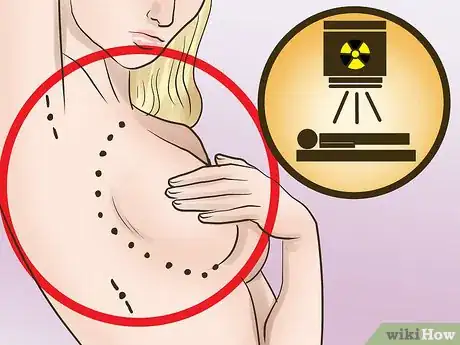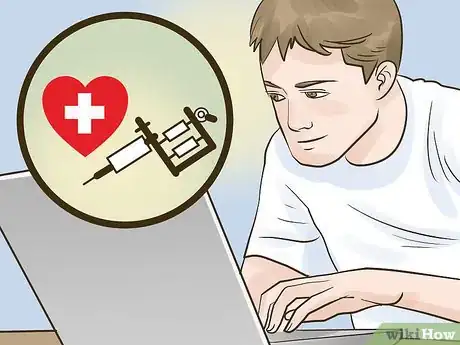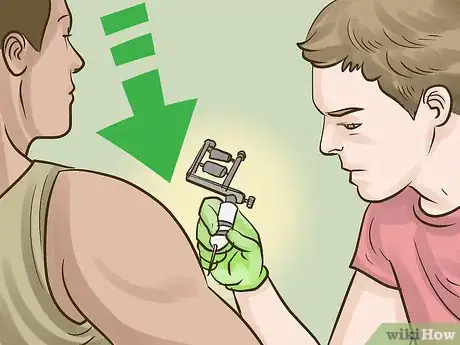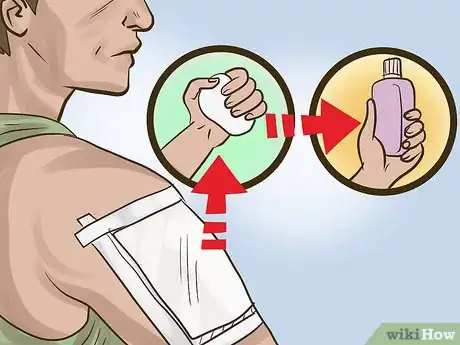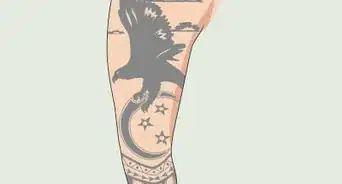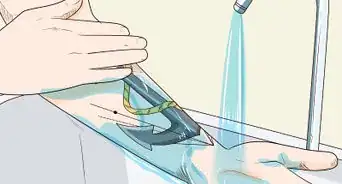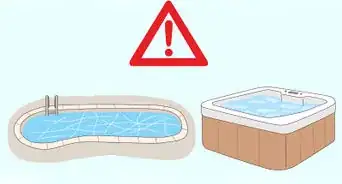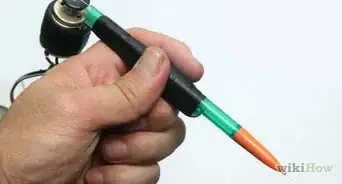This article was co-authored by Michelle Myles. Michelle Myles is the Co-owner of Daredevil Tattoo, a tattoo shop located based in New York City's Lower East Side. Michelle has more than 20 years of tattooing experience. She also operates the Daredevil Tattoo Museum, co-owner Brad Fink's personal collection of antique tattoo memorabilia that he has amassed over the last 27 years of tattooing.
This article has been viewed 20,506 times.
Medical Tattoos are permanent skin markings that serve a variety of medical purposes. Tattoos may be used to replace medical alert bracelets (medical alert tattoos), to aid in the process of radiotherapy (radiotherapy tattoos), to cover scars or replace pigment following a mastectomy (post-mastectomy tattoos), and/or to perform a function similar to “dog tags” for members of the US military (meat tag tattoos). To get a medical tattoo, you must determine the type of tattoo you need, plan your tattoo, and then follow through with obtaining it.
Things You Should Know
- There are no standardized rules when it comes to medical tattoos, so it’s possible that a medical professional won’t see it if you don’t get the tattoo in a highly visible area.
- Medical tattoos make the most sense when you have conditions where you won’t be able to communicate key information during an emergency.
- Consider putting the tattoo on/near your wrist where an EMT or doctor would see it when they go to take your pulse.
- It’s okay to take cosmetics into account and get a medical tattoo that looks good, but if it isn’t legible, it won’t do anyone any good in an emergency.
- Do not get a medical tattoo for any kind of radiotherapy; those markers need to be applied by a medical professional, and regular tattoo artists won’t use medical-grade tattoo ink.
Steps
Determine What Type of Medical Tattoo You Need
-
1Learn about “medical alert” tattoos. A “medical alert” tattoo is a tattoo that communicates important medical information about a patient, such as a severe allergy or the presence of a disease. These tattoos are meant to replace traditional medical alert bracelets, which can get lost. Although these tattoos are growing in popularity, there is still no consensus about the design or placement of such tattoos. This can make them more difficult for medical professionals to detect.[1] [2]
-
2Research “meat tag” tattoos. A “meat tag” is a tattoo on a member of the US military, meant to indicate essential identification data. These tattoos—which perform the same function and often mimic the appearance of traditional “dog tags”—are growing in popularity within the armed forces.[3]Advertisement
-
3Learn about “radiotherapy” tattoos. External radiotherapy (sometimes called external beam radiotherapy) is a form of cancer treatment that uses a machine to aim beams of radiation at cancer cells. A series of marks must be made on the patient’s skin—either small tattoos or dots of permanent marker—to guide the radiotherapy process. Radiotherapy tattoos are preferable to marks made by permanent marker because they cannot be accidentally washed off.[4]
- Unlike other medical tattoos, you may have this done directly by your radiographer.
- If you prefer to have these tattoos done at a studio, your radiographer can draw marks for your tattoo artist to follow.
-
4Look into “post-mastectomy” tattoos. Following breast surgery (usually a mastectomy, but sometimes also breast reductions) many patients opt to have tattoos done. These may be cosmetic—tattooing on an areola or replacing lost pigment—or aesthetic—an elaborate design to cover scars and/or signify one’s journey. Sometimes women opt to have a post-mastectomy tattoo instead of breast implants or other cosmetic surgery. Other times, these tattoos are in addition to cosmetic reconstruction.[5]
Planning Your Tattoo
-
1Brainstorm a design. With the exception of radiotherapy tattoos (which will be small dots), you will need to select a design for your tattoo. Even if you want something simple (such as plain text for a medical alert or meat tag tattoo, or the replacement of an areola), you will still need to make some decisions (such as selecting a font, size, and/or color). If you want your tattoo to be more elaborate, begin by doing some internet searches to get ideas. Then, meet with a tattoo artist to discuss details. Many artists will do a custom design for you, though some may charge a fee for this service.
-
2Choose a location on your body. The location of your tattoo will vary depending on the type of tattoo you need, and how large you want your tattoo to be. A tattoo artist can help you to make this decision. Be aware that some areas of the body are more painful to tattoo than others (such as the rib cage).
- A post-mastectomy tattoo will appear on the chest.
- Meat tag tattoos are traditionally done on the upper rib cage, although sometimes these appear on the chest.
- Work with your doctor to determine the proper placement of radiotherapy tattoos.
- Medical alert tattoos appear on a variety of bodily locations. To increase the likelihood that a medical professional will see and recognize your tattoo, consider placing it on your wrist or forearm, where you’d normally wear a medical alert bracelet.
-
3Talk to your doctor. Getting any kind of medical tattoo is a big decision. As such, it is good to discuss it with your doctor. If you have a disease or have recently had a medical procedure (like a mastectomy), your doctor can determine whether or not you are well enough to have a tattoo done.
Getting Your Medical Tattoo
-
1Find a reputable shop. Begin by doing an internet search for tattoo studios in your area and/or by getting recommendations from friends. Plan to go visit a few shops. There are several things you will want to look for in a reputable shop:
- A clean environment.
- Tattoo artists wearing gloves.
- Certificates hanging on the wall, such as a certificate for a “blood borne pathogens” training course, and a CPR certification.
- Artists portfolios (to see the quality of their work).
-
2Get your tattoo. Once you have chosen an artist, a design, and a location on your body, all that is left is to show up for your appointment and receive your tattoo. Your tattoo artist should be able to give you a rough estimate of how long the tattoo will take. Be aware that depending on the location of the tattoo, and your own tolerance for pain, getting that tattoo may be a painful experience.
- Be aware that tattoos can be expensive.
- Get a price from your tattoo artist before you begin and be sure you will be able to pay.
-
3Follow after-care instructions. After your tattoo is finished, it is important to take good care of it. A tattoo is essentially an open wound. Improper care can result in infection, and poor healing which can damage the tattoo.
- When the tattoo is finished, leave the bandage on for at least one hour.
- After one hour, remove the bandage and wash your tattoo with unscented antibacterial soap.
- After washing, apply a thin layer of unscented body lotion.
- Repeat this regimen once or twice per day, but no more than this.
- Avoid scratching, direct sunlight, swimming for 3-4 weeks until your tattoo is healed.
Expert Q&A
-
QuestionWhat is the most popular medical tattoo?
 Michelle MylesMichelle Myles is the Co-owner of Daredevil Tattoo, a tattoo shop located based in New York City's Lower East Side. Michelle has more than 20 years of tattooing experience. She also operates the Daredevil Tattoo Museum, co-owner Brad Fink's personal collection of antique tattoo memorabilia that he has amassed over the last 27 years of tattooing.
Michelle MylesMichelle Myles is the Co-owner of Daredevil Tattoo, a tattoo shop located based in New York City's Lower East Side. Michelle has more than 20 years of tattooing experience. She also operates the Daredevil Tattoo Museum, co-owner Brad Fink's personal collection of antique tattoo memorabilia that he has amassed over the last 27 years of tattooing.
Tattoo Artist & Co-owner, Daredevil Tattoo One of the most common medical tattoos is areolar pigmentation for those who've had a mastectomy. These tattoos are great ways to cover scars or highlight a part of a personal medical journey.
One of the most common medical tattoos is areolar pigmentation for those who've had a mastectomy. These tattoos are great ways to cover scars or highlight a part of a personal medical journey.
References
- ↑ http://health.usnews.com/health-news/patient-advice/articles/2015/08/20/what-to-know-before-getting-a-medical-alert-tattoo
- ↑ https://www.ncbi.nlm.nih.gov/pubmed/27682719
- ↑ http://www.theusmarines.com/meat-tags/
- ↑ http://www.cancerresearchuk.org/about-cancer/cancers-in-general/treatment/radiotherapy/external/plan/radiotherapy-skin-markings
- ↑ http://www.inkedmag.com/inspiring-mastectomy-tattoos/


